List of Medal of Honor recipients facts for kids
The Medal of Honor is the highest award a member of the United States military can receive. It was created during the American Civil War in 1861. This special medal is given to soldiers, sailors, airmen, marines, and coast guardsmen who show incredible bravery. They must risk their own lives far beyond what is expected, especially when fighting an enemy.
Because of how brave someone must be to earn it, the Medal of Honor is often given after a person has died. The President of the United States gives out this medal in the name of the United States Congress. More than 3,520 Medals of Honor have been awarded since 1861. A few people have even received it twice!
The stories of those who earned the Medal of Honor are often published in books. The first Army Medal of Honor went to Private Jacob Parrott during the Civil War. He earned it for his part in the Great Locomotive Chase. The earliest action for which the medal was awarded happened on February 13, 1861. This was for Bernard John Dowling Irwin during the Apache Wars.
The first African American to receive this award was Robert Blake. He bravely stayed at his post during a naval battle under heavy fire. While William Harvey Carney's brave actions happened earlier, he received his medal later. The only woman to receive the Medal of Honor is Mary Edwards Walker. She was a surgeon during the Civil War. Her medal was taken away in 1917 but given back by President Jimmy Carter in 1977.
Usually, only people serving in the U.S. Armed Forces can get the medal. However, there have been rare exceptions. For example, Charles Lindbergh received his medal as a civilian pilot. You don't have to be a U.S. citizen to get the medal either. Sixty-one Canadians serving in the U.S. military have received it. Most earned it during the American Civil War.
Contents
- Medals in the 19th Century
- Medals in the 20th Century
- United States Occupation of Veracruz (1914)
- Invasion and Occupation of Haiti (1915–1934)
- Occupation of the Dominican Republic (1916–1924)
- World War I (1914–1918)
- Occupation of Nicaragua (1909–1933)
- World War II (1939–1945)
- Korean War (1950–1953)
- Vietnam War (1959–1975)
- USS Liberty Incident (1967)
- Somalia (1993)
- Medals in the 21st Century
- Non-Combat Medals
- Foreign Recipients
Medals in the 19th Century
American Civil War (1861–1865)
The American Civil War was a conflict between the United States (the Union) and the Southern states. These Southern states formed the Confederate States of America. The Medal of Honor was created during this war. A total of 1,523 medals were given out for acts of bravery during this time. Thirty-three of these were given after the person had died. Most awards were given after the war ended.
Indian Wars
The Indian Wars were a series of conflicts in North America. They happened between the U.S. government and Native American groups. During these wars, 426 Medals of Honor were awarded to soldiers. Thirteen of these were given after the person had died.
Korean Expedition (1871)
The United States expedition to Korea in 1871 was the first American military action there. It is also known as Shinmiyangyo. This event happened mainly around Ganghwa Island. The U.S. military went to Korea to try and set up trade and diplomatic relations. They also wanted to find out what happened to the merchant ship General Sherman.
Korea's government at the time, the Joseon Dynasty, preferred to stay isolated. This led to fighting between the two sides. The United States did not achieve its goals during this expedition.
| Image | Name | Service | Rank | Place of action | Date of action | Unit | Notes |
|---|---|---|---|---|---|---|---|
|
|
John Andrews | Navy | Ordinary Seaman | aboard USS Benicia | Jun 9, 1871 – Jun 10, 1871 | USS Benicia | Stood on the gunwale on the Benicia's launch, lashed to the ridgerope and remained unflinchingly in this dangerous position and gave his soundings with coolness and accuracy under a heavy fire. |
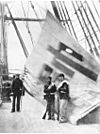 (Brown at right) (Brown at right) |
Charles Brown | Marine Corps | Corporal | aboard USS Colorado | June 11, 1871 | USS Colorado | Assisted in capturing the Korean flag from the citadel of the fort |
|
|
John Coleman | Marine Corps | Private | aboard USS Colorado | June 11, 1871 | USS Colorado | For hand-to-hand combat and saving the life of Alexander McKenzie |
|
|
James Dougherty | Marine Corps | Private | aboard USS Benicia | June 11, 1871 | USS Benicia | Returned to duty after being wounded several times |
|
|
Frederick Franklin | Navy | Quartermaster | aboard USS Colorado | June 11, 1871 | USS Colorado | For assuming command of Company D, after Lt. McKee was wounded, and handling the company until relieved |
|
|
Patrick H. Grace | Navy | Chief Quartermaster | aboard USS Benicia | Jun 10, 1871 – Jun 11, 1871 | USS Benicia | Carrying out his duties with coolness, Grace set forth gallant and meritorious conduct throughout this action |
 (Hayden at left) (Hayden at left) |
Cyrus Hayden | Navy | Carpenter | aboard USS Colorado | June 11, 1871 | USS Colorado | Serving as color bearer of the battalion, Hayden planted his flag and protected it under heavy fire |
 |
William F. Lukes | Navy | Landsman | Ganghwa Island | Jun 9, 1871 – Jun 10, 1871 | USS Colorado | Fighting the enemy inside the fort, Lukes received a severe cut over the head |
|
|
Alexander McKenzie | Navy | Boatswain's Mate | aboard USS Colorado | June 11, 1871 | USS Colorado | Fighting at the side of Lt. McKee during this action, McKenzie was struck by a sword and received a severe cut in the head from the blow. |
|
|
Michael McNamara | Marine Corps | Private | aboard USS Benicia | June 11, 1871 | USS Benicia | For taking a match-lock from the hands of the enemy while advancing to the parapet |
|
|
James F. Merton | Navy | Landsman | Ganghwa Island | Jun 9, 1871 – Jun 10, 1871 | USS Colorado | Merton was severely wounded in the arm while trying to force his way into the fort |
|
|
Michael Owens | Marine Corps | Private | aboard USS Colorado | June 11, 1871 | USS Colorado | Fighting courageously in hand-to-hand combat, Owens was badly wounded by the enemy during this action |
 (Purvis in center) (Purvis in center) |
Hugh Purvis | Marine Corps | Private | aboard USS Alaska | June 11, 1871 | USS Alaska | Braving the enemy fire, Purvis was the first to scale the walls of the fort and capture their flag |
|
|
Samuel F. Rogers | Navy | Quartermaster | aboard USS Colorado | June 11, 1871 | USS Colorado | Fighting courageously at the side of Lt. McKee during this action, Rogers was wounded by the enemy |
|
|
William Troy | Navy | Ordinary Seaman | aboard USS Colorado | June 11, 1871 | USS Colorado | Fighting at the side of Lt. McKee, by whom he was especially commended, Troy was badly wounded by the enemy |
Spanish–American War (1898)
The Spanish–American War was a conflict between Spain and the United States. It started in April 1898 and ended in December of that year. The war began after the U.S. asked Spain to let Cuba become independent. Spain refused.
The explosion of the U.S. warship USS Maine in Havana also increased tensions. News reports that made Spain look bad, called "yellow journalism", also stirred up American public opinion. The U.S. won important naval battles in the Philippines and Cuba. The Treaty of Paris ended the war. The U.S. gained control of Puerto Rico, the Philippines, and Guam. 111 Medals of Honor were given for actions in this war.
Samoan Civil War (Late 1800s)
The Samoan Civil War(s) took place in the Samoa Islands in the Pacific Ocean. This was a series of conflicts involving Germany, the United Kingdom, and the United States. These countries wanted Samoa as a place for their ships to refuel. They also wanted to gain more power. The wars ended in 1899 with the islands being divided.
| Image | Name | Service | Rank | Place of action | Date of action | Unit | Notes |
|---|---|---|---|---|---|---|---|
|
|
Frederick T. Fisher | Navy | Gunner's Mate First Class | aboard USS Philadelphia, Samoa | April 1, 1899 | USS Philadelphia | For distinguishing himself by his conduct in the presence of the enemy |
|
|
Bruno A. Forsterer | Marine Corps | Sergeant | Samoa | April 1, 1899 | Unknown | For distinguished conduct in the presence of the enemy. |
 |
Henry L. Hulbert | Marine Corps | Private | Samoa | April 1, 1899 | Unknown | For distinguished conduct in the presence of the enemy. Subsequently, awarded the Navy Cross and the Distinguished Service Cross for actions during World War I. |
|
|
Michael J. McNally | Marine Corps | Sergeant | Samoa | April 1, 1899 | Unknown | For distinguished conduct in the presence of the enemy |
Philippine-American War (1899–1902)
The Philippine–American War was a military conflict between the United States and Filipino fighters. These fighters had formed the “First Philippine Republic”. The war started in 1899 and officially ended in 1902. However, some fighting continued until 1913.
Eighty-six Medals of Honor were awarded during this war. Seventy were for the Army, ten for the Navy, and six for the Marine Corps. Four of these medals were given after the person had died. José B. Nísperos was the first Asian person to receive the Medal of Honor. He was honored for continuing to fight even after being wounded.
Boxer Rebellion (1899–1901)
The Boxer Rebellion was an uprising in China. It was led by a group called the Boxers. They were against foreign influence in China. The Boxers attacked foreigners and Chinese Christians. In June 1900, the Boxers attacked Beijing. A group of different countries sent 20,000 troops to rescue those trapped.
During this rebellion, 59 American service members received the Medal of Honor. Most of these went to Navy sailors and Marines. Harry Fisher was the only person to receive the medal after dying in this conflict.
Medals in the 20th Century
United States Occupation of Veracruz (1914)
The United States occupied the Mexican port of Veracruz for six months in 1914. This happened because of an incident called the Tampico Affair. Relations between Mexico and the U.S. were already difficult due to the Mexican Revolution.
Secretary of the Navy Josephus Daniels ordered 56 Medals of Honor to be given for this action. This is the most for any single event. In total, 63 Medals of Honor were awarded for actions during this occupation.
Invasion and Occupation of Haiti (1915–1934)
The first United States occupation of Haiti began in 1915 and lasted until 1934.
| Portrait | Name | Service | Rank | Place of action | Date of action | Unit | Notes |
|---|---|---|---|---|---|---|---|
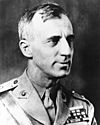 |
Smedley Butler | Marine Corps | Major | Fort Riviere, Haiti | November 17, 1915 | 2nd Marines | Second award – previously awarded a Medal of Honor for action in the Mexican Campaign. |
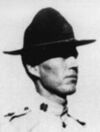 |
William R. Button | Marine Corps | Corporal | near Grande Riviere, Haiti | Oct 31, 1919 – Nov 1, 1919 | 7th Marines | For the assassination of rebel leader Charlemagne Péralte and the routing of his followers |
 |
Daniel Daly | Marine Corps | Gunnery Sergeant | near Fort-Liberté, Haiti | October 24, 1915 | 15th Company, 2nd Marines | Second award – previously awarded a Medal of Honor for action in the Boxer Rebellion |
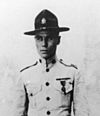 |
Herman H. Hanneken | Marine Corps | Sergeant | near Grande Riviere, Haiti | Oct 31, 1919 – Nov 1, 1919 | 7th Marines | For the assassination of rebel leader Charlemagne Péralte and the routing of his followers |
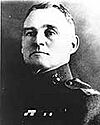 |
Ross L. Iams | Marine Corps | Sergeant | Fort Riviere, Haiti | November 17, 1915 | 5th Company, 2nd Marines | Approaching a breach in the wall which was the only entrance to the fort, Sergeant Iams unhesitatingly jumped through the breach despite constant fire from the Cacos and engaged the enemy in a desperate hand-to-hand combat until the bastion was captured and Caco resistance neutralized. |
|
|
Samuel Marguiles | Marine Corps | Private | Fort Riviere, Haiti | November 17, 1915 | 23rd Company, 2nd Marines | Served under the name Samuel Gross. |
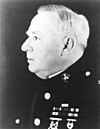 |
Edward A. Ostermann | Marine Corps | First Lieutenant | near Fort-Liberté, Haiti | October 24, 1915 | 15th Company, 2nd Marines | In command of one of the three squads which advanced in three different directions, led his men forward, surprising and scattering the Cacos, and aiding in the capture of Fort Dipitie. |
 |
William P. Upshur | Marine Corps | Captain | near Fort-Liberté, Haiti | October 24, 1915 | 15th Company, 2nd Marines | In command of the three squads which advanced in three different directions, led his men forward, surprising and scattering the Cacos, and aiding the capture of Fort Dipitie. |
Occupation of the Dominican Republic (1916–1924)
The United States occupied the Dominican Republic from 1916 to 1924. U.S. Marines took control of the country. They helped restore order and improve the country's finances. New roads were built, connecting different parts of the country. A professional military group was also created.
| Image | Name | Service | Rank | Place of action | Date of action | Unit | Notes |
|---|---|---|---|---|---|---|---|
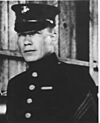 |
Joseph A. Glowin | Marine Corps | Corporal | Guayacanes, Dominican Republic | July 3, 1916 | 13th Company, Artillery Battalion, 1st Brigade | For action against a considerable force of rebels |
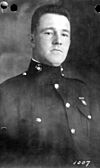 |
Ernest C. Williams | Marine Corps | First Lieutenant | San Francisco de Macorís, Dominican Republic | November 29, 1916 | 1st Brigade | For leading the capture of a fort |
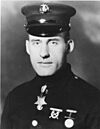 |
Roswell Winans | Marine Corps | First Sergeant | Guayacanes, Dominican Republic | July 3, 1916 | 1st Brigade | For action against a considerable force of rebels |
World War I (1914–1918)
World War I, also known as the Great War, was a huge global conflict. It happened mainly in Europe from 1914 to 1918. Millions of soldiers were involved, and over 40 million people were killed or injured. The war started after Archduke Franz Ferdinand was assassinated. This event led to many countries declaring war on each other.
During this war, 126 men received the Medal of Honor. Five Marines even received both the Army and Navy versions of the medal for the same brave action.
Occupation of Nicaragua (1909–1933)
The United States occupied Nicaragua for many years. This was to prevent other nations from building a canal there. It also aimed to stop ongoing civil wars. The occupation ended because a Nicaraguan fighter, Augusto César Sandino, led attacks against U.S. troops. Also, the Great Depression made it too expensive for the U.S. to stay.
| Image | Name | Service | Rank | Place of action | Date of action | Unit | Notes |
|---|---|---|---|---|---|---|---|
 |
Christian F. Schilt | Marine Corps | First Lieutenant | Quilali, Nicaragua | Jan 6, 1928 – Jan 8, 1928 | Observation Squadron 7-M | For evacuating wounded Marines by plane while under fire |
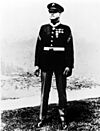 |
Donald L. Truesdale | Marine Corps | Corporal | near Constancia, near Coco River, northern Nicaragua | April 24, 1932 | a Guardia Nacional Patrol | Served under the name "Truesdale" before officially changing name to "Truesdell" on 25 July 1942. Lost his hand while attempting to save his patrol from an accidentally activated grenade. |
World War II (1939–1945)
World War II was a massive global conflict. It started in Asia in 1937 and in Europe in 1939. Most of the world's countries were divided into two main groups: the Allies and the Axis powers. Over 100 million military people were involved. It was the deadliest conflict in human history, with over 60 million people killed.
During this war, 471 U.S. military members received the Medal of Honor. 273 of these were given after the person had died. For example, 15 medals were given for actions during the Japanese attack on Pearl Harbor. 27 were given for actions during the Battle of Iwo Jima. The only Medal of Honor ever given to a member of the United States Coast Guard, Douglas Albert Munro, was for actions in this war.
Korean War (1950–1953)
The Korean War began when the North Korean Army invaded South Korea in 1950. The United States, China, and the Soviet Union also became involved. The main fighting lasted from June 25, 1950, until July 27, 1953. This is when the Korean Armistice Agreement was signed.
In South Korea, the war is often called "6•25" after its start date. In North Korea, it's called the Fatherland Liberation War. Sometimes, people call it "The Forgotten War." This is because it gets less attention than World War II and the Vietnam War. During this war, 146 Medals of Honor were awarded.
Vietnam War (1959–1975)
The Vietnam War was a long conflict that lasted from 1959 to 1975. It was fought between North Vietnam, supported by Communist countries, and South Vietnam, supported by the United States.
During and after the Vietnam War, 266 Medals of Honor were awarded. The first medal of the war went to Roger Donlon. He rescued wounded soldiers and led his group against the enemy. Milton L. Olive, III was the first African American recipient. He saved others by covering a grenade with his own body. Thomas Bennett was a medic who received the medal. He was a conscientious objector, meaning he refused to fight but served in other ways.
USS Liberty Incident (1967)
The USS Liberty incident was an attack on a U.S. Navy spy ship. It happened on June 8, 1967, during the Six-Day War. Israeli jet fighters and torpedo boats attacked the ship. This attack killed 34 crew members and wounded over 170. The ship was also badly damaged.
| Image | Name | Service | Rank | Place of action | Date of action | Unit | Notes |
|---|---|---|---|---|---|---|---|
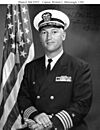 |
William L. McGonagle | Navy | Commander | Eastern Mediterranean Sea | June 8–9, 1967 | USS Liberty (AGTR-5) | Continued to lead his ship despite being severely wounded |
Somalia (1993)
On October 3, 1993, during the Battle of Mogadishu, U.S. Army Rangers and Delta Force members were on a mission. Two helicopters were shot down. Master Sergeant Gary I. Gordon and Sergeant First Class Randall D. Shughart were snipers in another helicopter. They saw the second helicopter crash. No ground forces could get to the crash site to protect the injured crew.
Gordon and Shughart asked to be dropped at the crash site. Their request was denied twice but approved on the third try. They only had their sniper rifles and pistols. When they reached the crashed helicopter, they pulled the crew out. They then set up a defense, fighting the attacking Somalis. Gordon and Shughart were both killed after running out of ammunition. The only survivor, Michael Durant, was taken hostage.
On May 23, 1994, President Clinton gave the Medal of Honor to the widows of Gordon and Shughart. They are the only snipers to have received this medal. The movie Black Hawk Down tells their story.
Medals in the 21st Century
War in Afghanistan (2001–2021)
The War in Afghanistan began on October 7, 2001. It was launched by the United States and its allies after the September 11 attacks. The goal was to capture Osama bin Laden, destroy al-Qaeda, and remove the Taliban government. The Taliban had supported al-Qaeda.
Since 2001, 18 American service members have received the Medal of Honor for actions in Afghanistan. Four of these were given after the person had died. Army Sergeant First Class Jared C. Monti received his medal for trying to rescue a wounded soldier. Navy Lieutenant Michael P. Murphy received his for fighting enemy forces. He sacrificed his life to call for help when his team was outnumbered.
Salvatore Giunta was the first living person since the Vietnam War to receive the medal. He risked his life to save a wounded friend. Sergeant First Class Leroy Petry also received the medal from President Obama. Marine Corps Corporal Dakota Meyer became the third living recipient. He was honored for his actions during the Battle of Ganjgal.
Iraq War (2003–2011)
The Iraq War, also known as Operation Iraqi Freedom, began on March 20, 2003. The United States led a group of countries to invade Iraq. Seven service members have received the Medal of Honor for actions in Iraq. Five were from the Army, one from the Marine Corps, and one from the Navy.
Paul Ray Smith was the first to receive it. He held back enemy forces, allowing wounded soldiers to be safely moved. Other recipients include Staff Sergeant David Bellavia and Staff Sergeant Travis Atkins. Corporal Jason Dunham of the Marine Corps, Specialist Ross A. McGinnis of the Army, and Master-at-Arms Second Class Michael A. Monsoor of the U.S. Navy also received the medal. These four bravely used their own bodies to cover explosive devices. This protected their comrades. On December 16, 2021, Sergeant First Class Alwyn Cashe was awarded the medal after his death for his bravery.
Non-Combat Medals
Before 1963, the Medal of Honor could be given for actions not involving direct fighting. 193 men earned the medal this way. Most of these medals were for rescuing people from drowning. One example is Fireman Second Class Telesforo Trinidad. He is the only Asian American sailor to receive the Medal of Honor for a rescue.
William Halford received the medal for sailing for 31 days in a small boat. He got help for his crew who were stranded on an island. Three explorers also received the medal through special acts of Congress. Charles Lindbergh got his for being the first to fly solo across the Atlantic Ocean. Floyd Bennett and Richard Evelyn Byrd received theirs for what was thought to be the first flight to the North Pole and back.
Foreign Recipients
The Medal of Honor is usually given to members of the U.S. Armed Forces. However, it has been given to five unknown soldiers from allied countries after World War I. These include the British Unknown Warrior and the French Unknown Soldier. Each of these countries also gave their highest medals to the U.S. Unknown Soldier.

